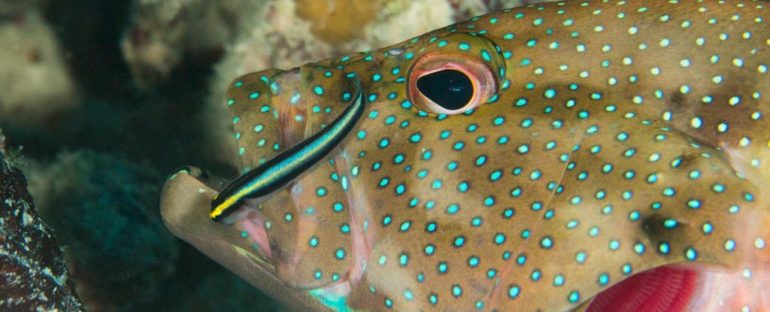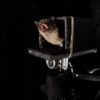If you saw the first episode of David Attenborough‘s new BBC series Perfect Planet, you will have seen the astounding bloodsucking behaviour of the vampire finches. These small birds exist only on two remote islands in the Galapagos and have evolved to drink the blood of much larger seabirds.
You will also have seen the curious behaviour of the booby, the seabird that the finch was gulping blood from – it didn’t seem bothered, and it didn’t try to get rid of the finch.
So how might this bloodsucking and relative lack of resistance have evolved?
It likely began with a process called “mutualism”, where both individuals gain from a relationship.
Cleaner fish such as the cleaner wrasse, for example, set up a cleaning station, typically in coral reefs. Larger fish, octopus or turtles visit the cleaning station to get the smaller fish to remove any dead skin, infected tissue, or external parasites.
The relationship between a cleaner wrasse and their “client” is beneficial to the client as it gets cleaned, helping it to stay healthy.
But the cleaner wrasse also benefits as they can eat the parasites and won’t themselves be eaten by the client – a winning situation all round.
Nevertheless, the evolutionary relationship can turn sour. What if the cleaner wrasse wasn’t so careful, and accidentally bit the client?
Suddenly, the cleaner benefits from a meal of nutritious flesh. This individual will have acquired more nutrients than usual, giving it an advantage (no matter how small) over all other cleaner wrasse.
The advantage allows it to survive long enough to reproduce and pass on its genes to the next generation. If this clumsy cleaning is heritable, rather than the more careful behaviour, the offspring will also possess the “clumsy gene” that results in flesh-eating.
Over time, all individuals of the species will eat flesh, as it is more beneficial than leaving it – the process of evolution via natural selection.
Perhaps something like this happened with the “bluestriped fangblenny”, a mimic that looks identical to juvenile bluestreak cleaner wrasse.
The larger client fish assumes that the blenny provides a cleaning service, so waits patiently to be cleaned, allowing the blenny to avoid predation. But the blenny doesn’t ever clean the client – instead, it bites a chunk out of the larger fish.
The blenny has even evolved an opioid-based venom that numbs the pain of the client long enough for it to escape.
As you can see, this is hardly a mutualistic relationship – the blenny is the clear winner at the cleaning station as it has gained a nutritious meal, while the client now has an injury as well as its parasites.
An evolutionary arms race
There are many parasitic species in the natural world, from animals such as cuckoos that deceive other species into raising their young, to bee orchids that deceive insects into pollinating them.
However, what we might be seeing is the result of a longstanding co-evolutionary arms race, where species evolve in response to another.
In the broad example of terrestrial predators and prey, imagine a scenario thousands of years ago where all species ran at the same speed – there would be no advantage to either predators or prey.
Yet, if the prey gradually evolved hooves, their feet would create less friction with the ground, enabling the prey to run faster than the predators.
The predators would be losing the battle until they evolved a response – perhaps having non-retractable claws to maximise traction, as the cheetah does, allowing them to be in the lead in the evolutionary race.
(Nick Dale/EyeEm/Getty Images)
These co-evolutionary relationships can continue, and can even change tack, so instead of evolving to achieve an even faster speed, the prey could evolve to jump like springbok antelopes to confuse the predators with evasive manoeuvres.
In fact, the Red Queen hypothesis states that species need to evolve constantly, not to win, but merely to stay alive. The hypothesis comes from Lewis Carroll’s Through the Looking Glass, where the Red Queen explains looking-glass land to Alice:
Now, here, you see, it takes all the running you can do, to keep in the same place. If you want to get somewhere else, you must run at least twice as fast as that!
Interestingly, oxpecker birds found in African savannahs feed in a similar way to the vampire finches. They remove parasites from large mammals such as giraffe or rhino, but they also feed on ear wax and blood, preventing wounds from healing by pecking at scabs. This seems like a standard parasitic relationship, where the oxpeckers have the advantage.
But, like the vampire finches, the oxpeckers aren’t actively removed by the mammals.

In fact, they provide an additional benefit – they act as lookouts for predators. If the oxpeckers see a predator approaching, they warn their mammal host who can respond accordingly.
The relationship between the vampire finch and booby may well have been a mutualistic relationship that has evolved into a parasitic one. Is this the start of an evolutionary battle between the two species? Or perhaps, like the oxpecker, there is more to this relationship that we have yet to discover.
Louise Gentle, Senior Lecturer in Wildlife Conservation, Nottingham Trent University.
This article is republished from The Conversation under a Creative Commons license. Read the original article.



